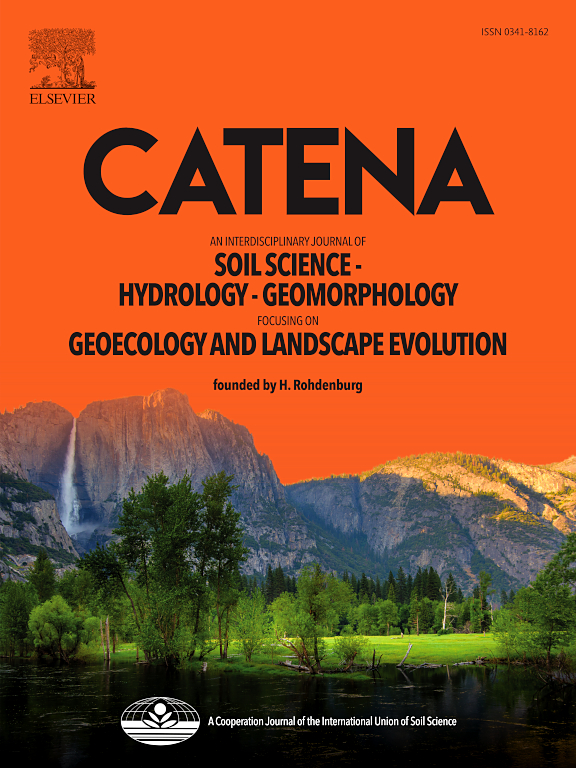Decoding soil carbon and nitrogen dynamics: The integrated role of biotic and abiotic drivers in subtropical forests
IF 5.4
1区 农林科学
Q1 GEOSCIENCES, MULTIDISCIPLINARY
引用次数: 0
Abstract
Accurate estimation of carbon (Scs) and nitrogen (Sns) stocks in forest soils is crucial. In subtropical forests, this storage is influenced by the interplay of various biotic and abiotic factors, including biological attributes such as plant diversity, litter characteristics, and microbial biomass, as well as abiotic attributes like climate, topography, and soil characteristics. However, the relative importance of these interplaying factors in influencing Scs and Sns in subtropical forests remains inadequately understood. In this study, we quantified the Scs and Sns across different soil layers in typical subtropical forests (coniferous, mixed coniferous-broadleaf, and broadleaf forests), and used partial least squares path modeling to determine the relative importance of biotic and abiotic factors on Scs and Sns. Results showed that Scs and Sns declined as soil depth increased, with no significant differences observed among the forest types. However, the driving factors varied significantly across forest types, with soil properties exerting the strongest impact on carbon and nitrogen sequestration. We observed a pronounced synergistic relationship between Scs and Sns. Among the biotic factors, plant diversity and litter characteristics indirectly modulated Scs and Sns by regulating soil water content (SWC) and pH levels. In terms of abiotic factors, elevated altitude and lower temperatures limited plant growth, slowed litter decomposition, and enhanced carbon and nitrogen accumulation. In contrast, adequate SWC and nutrient availability favored the accumulation of organic matter, while soil acidification could lead to carbon and nitrogen loss. In conclusion, forest management strategies that prioritize the optimization of SWC and nutrient conditions are instrumental in fostering carbon and nitrogen sequestration, thus contributing to climate change mitigation.
解码土壤碳氮动态:亚热带森林生物和非生物驱动因素的综合作用
准确估算森林土壤中碳(Scs)和氮(Sns)储量至关重要。在亚热带森林中,这种储量受多种生物和非生物因素的相互作用影响,包括植物多样性、凋落物特征和微生物生物量等生物属性,以及气候、地形和土壤特征等非生物属性。然而,这些相互作用因素在影响亚热带森林中Scs和Sns中的相对重要性仍然没有得到充分的了解。在本研究中,我们量化了典型亚热带森林(针叶林、针叶林-阔叶林和阔叶林)不同土层的Scs和Sns,并利用偏最小二乘路径模型确定了生物和非生物因子对Scs和Sns的相对重要性。结果表明,随着土壤深度的增加,土壤中Scs和Sns含量呈下降趋势,不同森林类型间差异不显著。然而,不同森林类型的驱动因子差异显著,土壤性质对碳氮固存的影响最大。我们观察到Scs和Sns之间存在明显的协同关系。在生物因子中,植物多样性和凋落物特征通过调节土壤含水量和pH水平间接调节Scs和Sns。在非生物因子方面,海拔升高和温度降低限制了植物的生长,减缓了凋落物的分解,增加了碳氮的积累。相反,充足的SWC和养分有效性有利于有机质的积累,而土壤酸化可能导致碳和氮的损失。总之,优先优化SWC和营养条件的森林管理战略有助于促进碳和氮的固存,从而有助于减缓气候变化。
本文章由计算机程序翻译,如有差异,请以英文原文为准。
求助全文
约1分钟内获得全文
求助全文
来源期刊

Catena
环境科学-地球科学综合
CiteScore
10.50
自引率
9.70%
发文量
816
审稿时长
54 days
期刊介绍:
Catena publishes papers describing original field and laboratory investigations and reviews on geoecology and landscape evolution with emphasis on interdisciplinary aspects of soil science, hydrology and geomorphology. It aims to disseminate new knowledge and foster better understanding of the physical environment, of evolutionary sequences that have resulted in past and current landscapes, and of the natural processes that are likely to determine the fate of our terrestrial environment.
Papers within any one of the above topics are welcome provided they are of sufficiently wide interest and relevance.
 求助内容:
求助内容: 应助结果提醒方式:
应助结果提醒方式:


